Are you overlooking the power of job titles on your resume?
You’re not the only one. Many job seekers treat professional titles as an afterthought—just something you copy from your past contracts or LinkedIn profile. But here’s the truth: the job titles you choose can directly impact whether your resume gets noticed or ignored.
Whether it's your resume headline, summary section, or work experience descriptions, using targeted and relevant job titles can significantly boost your chances of getting interviews. Especially in 2025’s competitive job market, where applicant tracking systems (ATS) are stricter than ever, the right title can make all the difference.
Should you always use the exact titles given by your previous employers? Not necessarily.
Instead, focus on writing optimized job titles that align with the roles you’re applying for—without being misleading. This means choosing terminology that reflects your actual responsibilities while matching the keywords recruiters and hiring managers are actively searching for. Remember, your resume is just the first step—finding the right interview outfit also matters. Explore our expert advice on what to wear for a job interview.
Think of your job title as a keyword—it needs to be accurate, strategic, and tailored for the job you want next.
What Is a Job Title

A specific designation of a post within an organization, normally associated with a job description that details the tasks and responsibilities that go with it. -- from WiKtionary
Each job title is usually tied to a specific job description that outlines key duties, required qualifications, and performance expectations. Job titles help define an employee’s role in the organizational structure and are used in everything from resumes and LinkedIn profiles to job postings and company directories.
Understanding and using the right job titles is essential when applying for jobs, as recruiters often filter resumes based on these terms. A well-chosen professional title improves resume visibility, enhances ATS optimization, and ensures your application aligns with the employer’s expectations.
Job Title on Your Resume
When crafting your resume, knowing where and how to include job titles can make a significant difference in capturing recruiters’ attention.
There are two primary places where job titles appear on a resume:
- The Dedicated Job Title Section (often part of your resume header or summary)
- The Work Experience Section, where you detail each role you’ve held
Understanding the distinct purposes of these sections is essential for optimizing your resume’s impact and improving your chances of landing an interview.
The Dedicated Job Title Section serves as a quick snapshot of your professional identity. This is where you highlight your current or target job title to immediately tell hiring managers and applicant tracking systems (ATS) what role you’re aiming for. Think of it as your resume’s headline—it should be clear, concise, and keyword-rich to align with the jobs you’re applying for.
The Work Experience Section, on the other hand, is where you list your previous job titles along with detailed descriptions of your duties and achievements. Here, accurate and tailored job titles paired with relevant keywords help demonstrate your experience and skills in context, improving your resume’s ATS compatibility.
By strategically placing and optimizing job titles in both sections, you create a cohesive narrative that showcases your qualifications effectively—making your resume stand out in today’s competitive job market.
For more tips on crafting an effective professional identity, check out our guide on software engineer resume summary.
How to Create a Job Title Section for the Role You’re Targeting
A job title section on your resume is a brief, focused area that clearly states the specific position you are seeking. This small but powerful element is crucial—especially when you’re competing in a crowded job market in 2025.
Think of this section as your resume headline—a precise label that immediately communicates your professional identity and target role to recruiters and applicant tracking systems (ATS).
For example, if you’re a culinary expert aiming for a Head Chef role at a luxury restaurant, your job title section might look like this:

Example
John Doe
Head Chef with over 10 years of fine dining experience
In this example, the applicant clearly states the desired job title and supports it with a brief, impactful summary of their experience level.
Typically, the job title section is placed directly beneath your name and contact details, making it one of the first things hiring managers see. Keep this statement concise and focused—it should quickly convey who you are professionally and the role you want next.
It’s important to distinguish this from a professional objective or summary statement. Unlike these longer sections, which provide detailed background or career goals, the job title section is succinct and targeted—serving as a clear signal of your job search focus.
Including a well-crafted job title section can boost your resume’s clarity, improve keyword relevance, and increase your chances of getting noticed in today’s competitive hiring landscape.
How to List Job Titles in Your Work Experience Section
The second critical place to feature job titles on your resume is within the work experience section. Here, you list the official titles of your previous roles along with your key responsibilities and achievements.
When adding job titles in this section, keep these important factors in mind:
- Clarity and Accuracy: Your job title should clearly reflect your role and responsibilities. It needs to be easily understood by hiring managers and ATS software alike.
- Career Progression: If you held multiple positions at the same company, make sure to list each title separately to highlight your promotions and professional growth over time. This demonstrates your ability to advance and take on more responsibility.
- Consistency and Honesty: Use the exact job titles you were given, unless they are unclear or outdated. In those cases, it’s acceptable to use a more recognized equivalent, but always remain truthful and avoid exaggeration.
Employers often scan job titles first to quickly assess your background, so accurate and well-structured job titles in your job history are essential for making a strong impression.
By carefully presenting your work experience job titles, you improve your resume’s credibility and help recruiters understand your career trajectory and skill set clearly.
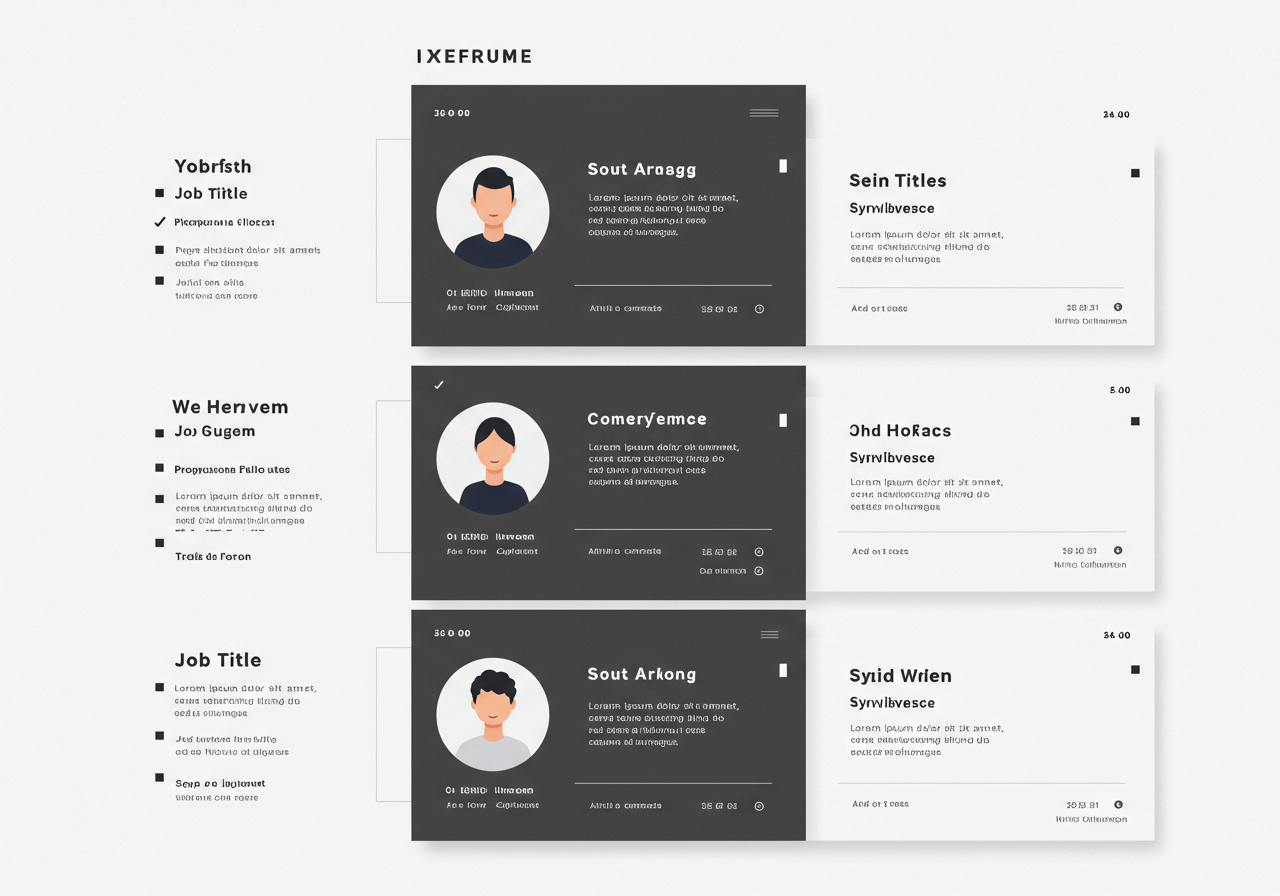
Professional Job Titles for Resume Summaries
The professional job title you write at the very top of your resume—usually within your resume summary or headline—is one of the most important elements of your job application. It’s the first thing recruiters and applicant tracking systems (ATS) notice, so making it clear and compelling is key to grabbing attention.
Examples of Popular Job Titles for Resumes
Here are some widely used professional job titles that fit many industries:
- Administrative Assistant
- Executive Assistant
- Marketing Manager
- Customer Service Representative
- Nurse Practitioner
- Software Engineer
- Sales Manager
- Data Entry Clerk
- Office Assistant
Your opening job title should follow two essential rules:
- Grab Recruiters’ Attention — Your title needs to immediately communicate your professional identity.
- Include ATS Keywords — Use terms that applicant tracking systems recognize to increase the chances of your resume making it through automated screening.
The simplest and most effective strategy is to match your professional title to the exact job title used in the job posting. For example, if the employer is looking for a “Project Manager,” use that title verbatim in your summary or headline.
While you might want to get creative or stand out with a catchy title, it’s better to keep the professional job title straightforward and aligned with industry standards. Your personality and unique skills can shine through in the resume summary’s body, where you have more room to elaborate.
If you choose to tweak the job title, make sure to use industry-related keywords and terms commonly recognized by recruiters. This approach demonstrates your understanding of the role and ensures your resume is optimized for ATS keyword scanning.
Common Mistakes to Avoid in Resume Job Titles
- Too Long: Keep it concise, ideally 4 words or fewer.
- Using Jargon: Avoid obscure internal titles; stick to widely understood industry terms.
- Superlatives or Adjectives: Skip words like “best,” “greatest,” or “expert” in the title itself.
- Too Personal: Remember, this is a professional label—save personal details and interests for other sections.
By carefully crafting your professional job title for your resume summary, you set the tone for the rest of your application and boost your chances of landing an interview in 2025’s competitive job market.
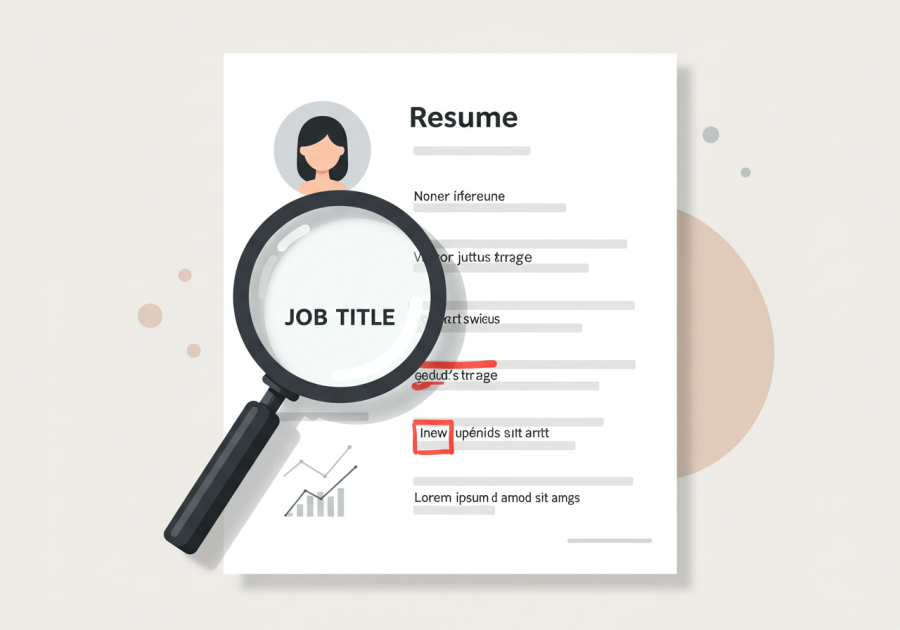
Can You Change Your Job Title to Better Reflect Your Role?
It’s common to feel that your official job title doesn’t fully capture your actual duties and responsibilities. Naturally, you might want to modify or update your job title on your resume to better highlight your skills and experience.
However, it’s important to strike a balance between accuracy and honesty. Overchanging or exaggerating your job title can appear misleading, and if a hiring manager contacts your previous employer, discrepancies might lead to your application being rejected.
Sometimes, companies use unique or internal job titles that don’t clearly convey the role outside the organization. For example, a restaurant might call its shift supervisors “community leaders.” While this may make sense internally, it can confuse recruiters or ATS software scanning your resume.
If you find yourself in this situation, the best approach is to discuss any changes with your previous employer beforehand. This ensures that if the hiring manager reaches out, your adjusted title is verified and understood.
Remember, the key to overcoming vague or unusual job titles lies in writing detailed, concise job descriptions. Use this space to clearly outline your responsibilities, achievements, and skills—this gives recruiters a more accurate picture of your role, regardless of the official title.
How to List Job Titles on Your Resume
Your job titles play a crucial role in showcasing your work experience and setting you apart from other candidates. When listed strategically, they can give you a competitive edge and demonstrate your qualifications clearly.
Not all job titles carry the same weight with recruiters. The key is to present your job titles in a way that highlights why you’re the best fit for the position you’re applying for.
Here are three essential factors to keep in mind when listing job titles on your resume:
Relevance
Place the most relevant job titles near the top of your work experience section—especially those that closely match the role you’re targeting. While chronological order matters, emphasizing job titles that align with the job description helps recruiters quickly see your suitability.
Responsibilities
After each job title, include a concise, bulleted list of your key responsibilities. These should directly relate to your title and provide clear insight into what your role entailed. Well-crafted descriptions not only support your job title but also showcase your skills and achievements effectively.
Recognition
Job titles that indicate higher levels of responsibility, such as “Manager,” “Senior,” or “Lead,” carry more influence with hiring managers. Choosing clear, widely recognized titles helps demonstrate your professional growth and ability to handle advanced roles.
By thoughtfully ordering and describing your job titles, you create a powerful narrative that captures both human readers and ATS algorithms—maximizing your chances of landing interviews.
How JobHun Supports Your Job Title Strategy and Resume Writing
Navigating the complexities of job titles and resume optimization can feel overwhelming, especially with the evolving demands of the 2025 job market. That’s where platforms like JobHun come into play, offering tools and resources designed to simplify this process.
JobHun helps job seekers identify the most relevant and industry-appropriate job titles by providing access to up-to-date job listings and detailed role descriptions. This insight allows you to align your resume titles closely with what employers are actively searching for, improving both recruiter appeal and ATS compatibility.
Beyond job titles, JobHun also offers guidance on crafting concise job descriptions, optimizing resume summaries, and selecting keywords—key components that enhance how your experience is perceived. With these resources, you can confidently tailor your resume to reflect both your true responsibilities and the language recruiters expect.
In today’s competitive job environment, having a clear strategy for presenting your job titles and experience isn’t just helpful—it’s essential. Utilizing tools that support this process, such as JobHun, can make your job search more focused and effective.
Go to the JobHun Website
Start by visiting any webpage of JobHun.com.
Once you're on the homepage, click the 👤 profile icon in the upper-right corner. This will take you to JobHun’s resume builder web app.
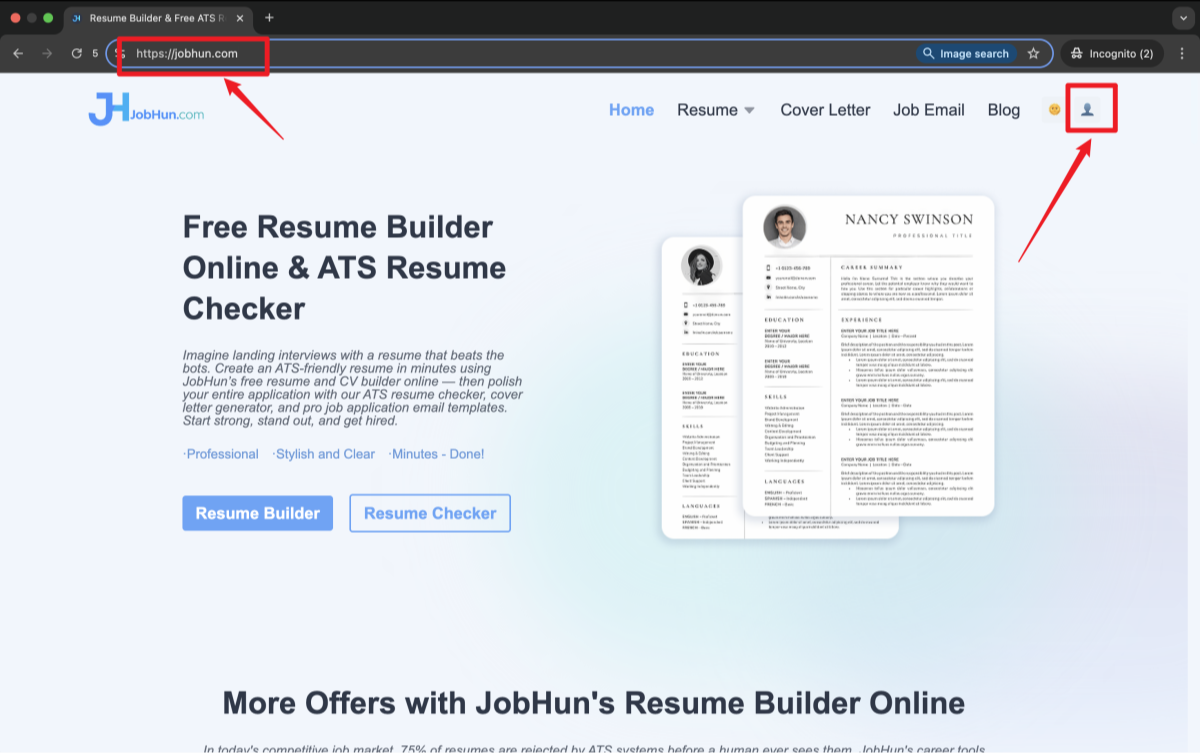
Access the Resume Dashboard
You’ll get to the Resume Builder's Webapp page of JobHun.
If you’re not logged in yet, the site will prompt you to sign up or log in.
- Click the “New Resume” button, or
- Click “Go to Login” in the upper-right corner.
Either option will take you to the sign-in page.
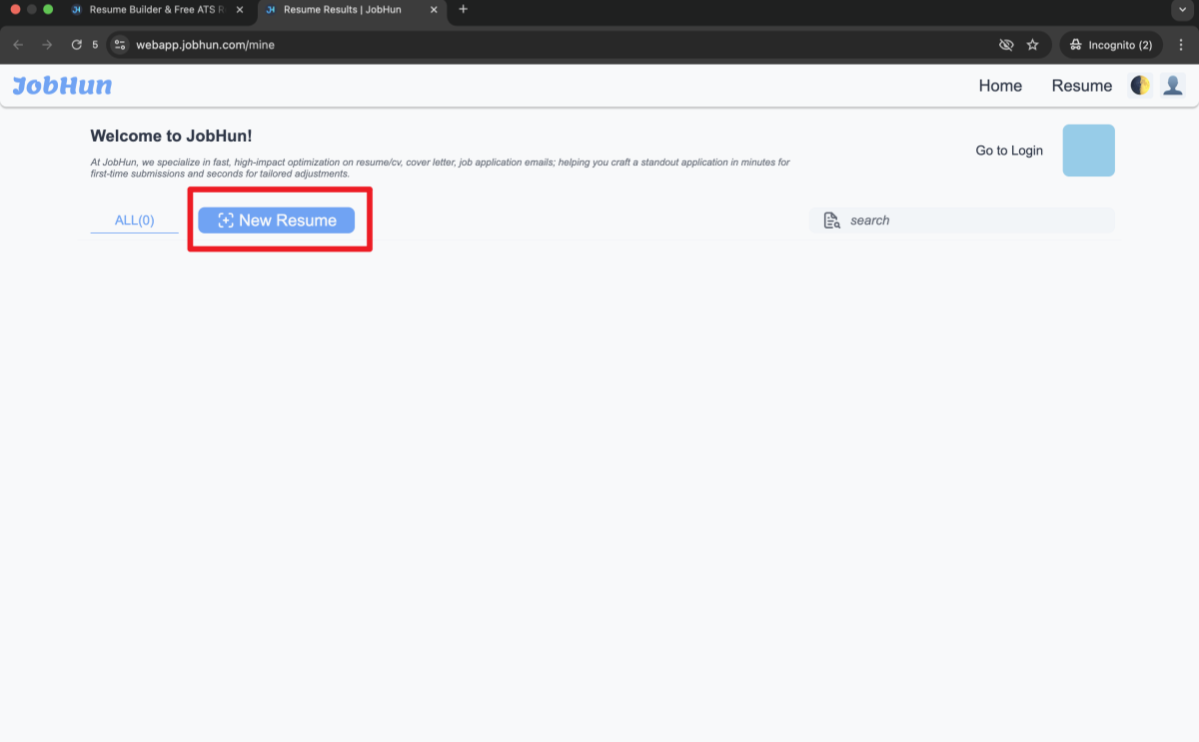
Sign Up or Log In to Your Account
You have two login options:
- Use your Google account for quick access
- Or manually enter your email, password, and name, then click “Go”
Once you're signed in, your personal dashboard will appear.
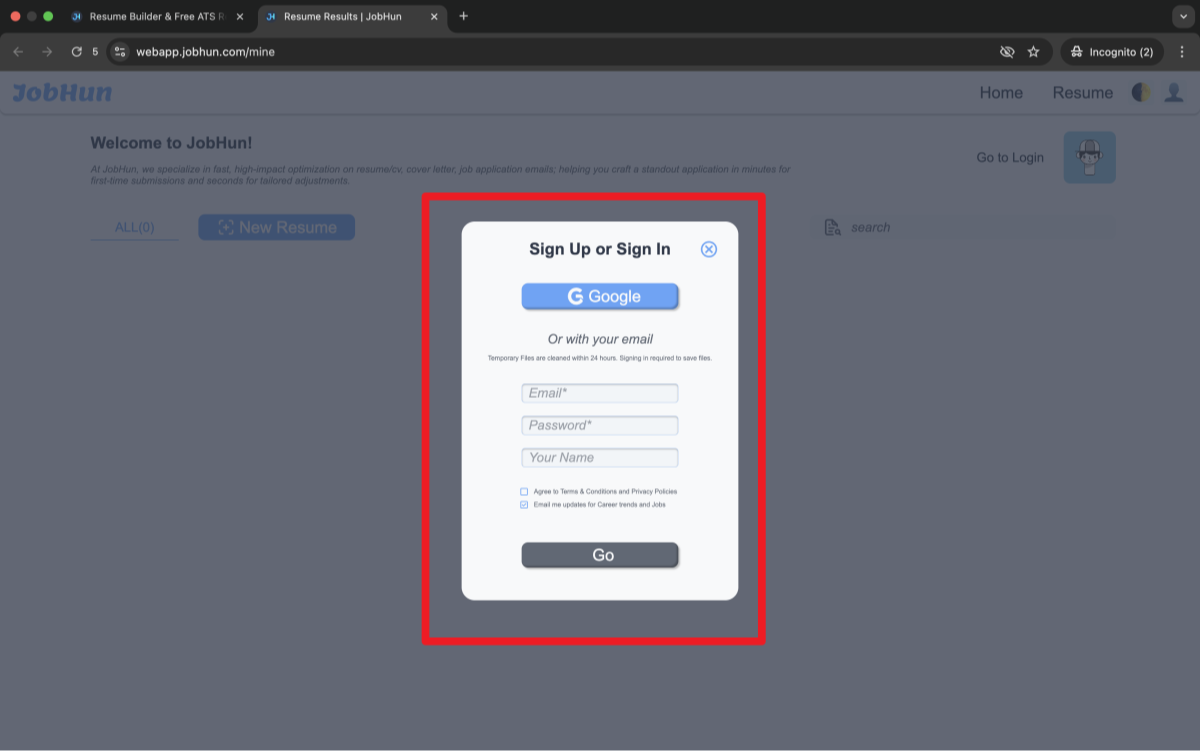
Click “New Resume” to Get Started
Now that you’re logged in, your profile details (name, email, join date) will show in the top-right corner.
Click the “New Resume” button again to open the AI resume builder.
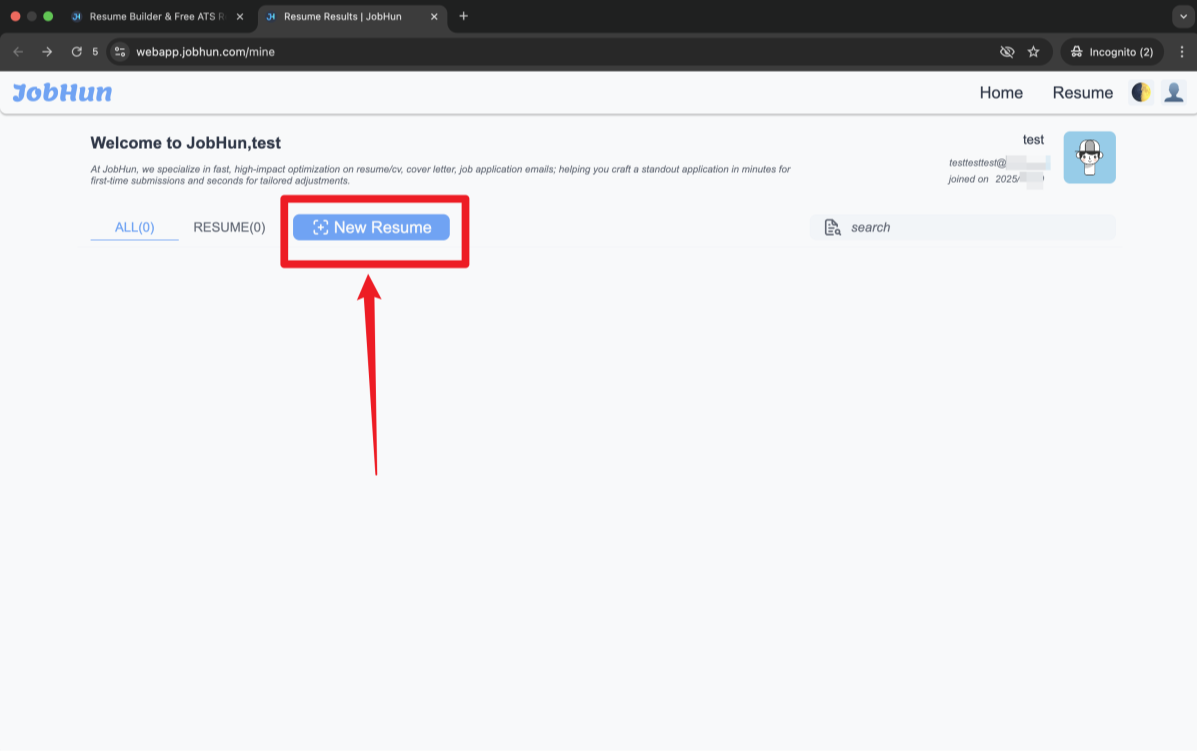
Build and Customize Your Resume
The resume builder layout is split into two main parts:
- Left panel: Your control dashboard, where you can add, edit, or organize resume sections (summary, experience, skills, etc.)
- Right panel: A live preview of your resume that updates as you make changes
You can now:
- Use AI to auto-generate resume content
- Manually edit each section
- Format, reorder, and polish until you're happy with the result
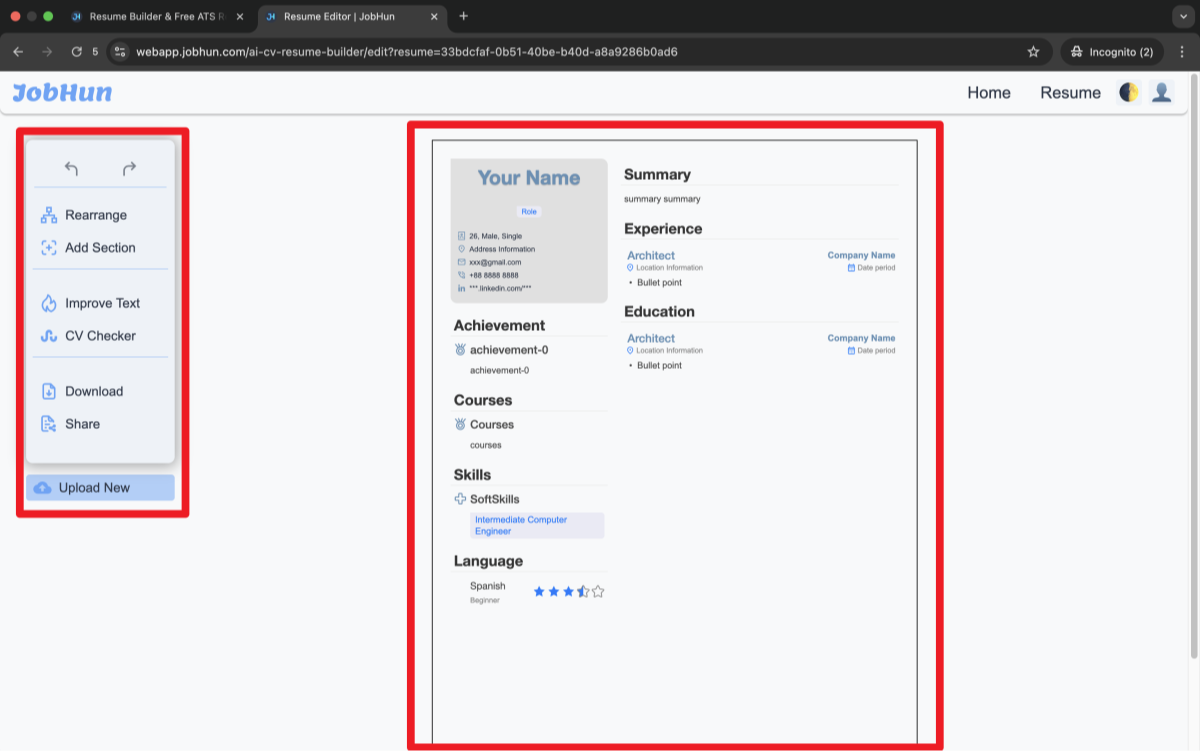
Conclusion
Choosing and presenting the right job titles on your resume is a powerful way to stand out in today’s competitive job market. Whether it’s crafting a targeted job title section, accurately listing past roles in your work experience, or aligning your titles with ATS-friendly keywords, every detail matters.
Remember, your job titles should not only reflect your actual responsibilities but also highlight your relevance to the position you’re applying for. Clear, concise descriptions paired with well-chosen titles help recruiters quickly understand your qualifications and career progression.
By taking the time to optimize your job titles and job descriptions, you enhance both human and automated review processes, significantly increasing your chances of landing interviews.
With the right approach and helpful tools like those offered by JobHun, you can confidently navigate the job search landscape, present yourself effectively, and move closer to your next career opportunity.




